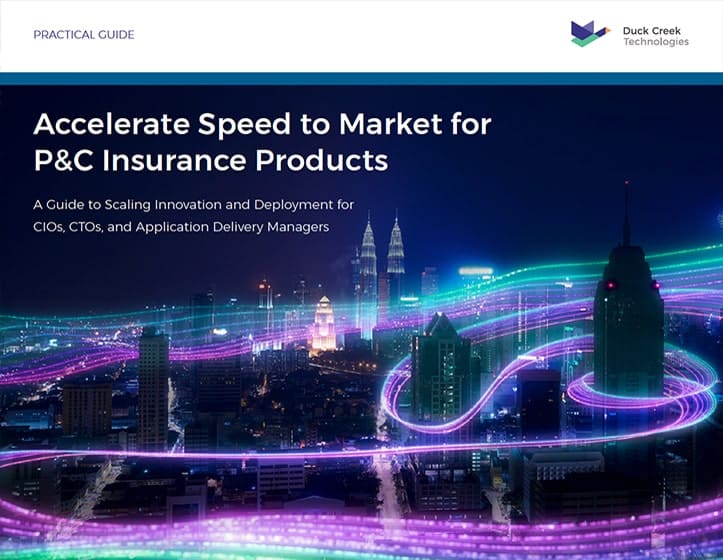The future of insurance is being shaped by data, and predictive analytics is no longer optional—it is the engine behind growth, efficiency, and competitive advantage in a rapidly evolving industry.
According to McKinsey’s 2025 report on The Future of AI in the Insurance Industry, global insurers that strategically adopt AI—including predictive analytics—are gaining a significant competitive edge.
In this blog, our experts explore 11 high-impact use cases where predictive analytics is fueling smarter decisions, operational efficiency, and meaningful growth across the insurance value chain.
How Predictive Analytics Are Driving Growth in P&C Insurance
Predictive analytics tools now pull data from a wide range of internal and external sources to better understand and anticipate how policyholders (the insured) are likely to act—especially in ways that impact risk, claims, or customer service. Property and casualty insurers are leveraging inputs from telematics, agent and customer interactions, smart home devices, and even social media to gain deeper insights into policyholder needs. These data streams help carriers strengthen relationships, streamline claims processing, and refine underwriting decisions with greater precision and speed.
Another closely related tool, “what-if” modeling, allows insurers to prepare for the underwriting workload, produce data for filings, and evaluate the impact of a change on an insurer’s book of business.
Together, predictive analytics and modeling are giving insurers the power to move from reactive to proactive—anticipating needs, optimizing operations, and making smarter decisions at scale. But how exactly are these tools being applied across the insurance value chain?
Below are 11 high-impact use cases that show how predictive analytics is driving meaningful growth—from underwriting and claims to customer experience and market expansion.
#1 Predictive Pricing & Smarter Risk Selection in Insurance
Pricing and risk selection are poised for major improvements in 2026, thanks to more sophisticated and diverse data sources. As insurers gain access to richer, real-time information, the insights they generate become far more actionable.
Much of this data is firsthand collected directly from telematics, smart devices, social media, and interactions between claims specialists and customers. Unlike traditional third-party data sources, these direct inputs offer a more accurate and timely view of policyholder behavior. That immediacy and relevance make predictive analytics especially powerful in refining pricing strategies and improving risk selection for P&C insurers.
But just how much data are insurers collecting from IoT-enabled devices? Citing telematics as an example, Statista reported a growth of the global vehicle telematics market from 75B USD in 2020 to 103B in 2022. Insurers can expect more data to be collected from IoT devices over the next few years.
See how Duck Creek’s partnership with Novo empowered the telematics start-up to scale their business at speed.
#2 Using Predictive Analytics to Identify At-Risk Insurance Customers Before Cancellation
Predictive analytics helps P&C insurers identify customers who may need special attention—such as those likely to cancel policies, reduce coverage, or express dissatisfaction. With access to more advanced data insights, carriers can proactively spot early warning signs of disengagement or dissatisfaction.
Much of this data comes directly from customer interactions, smart devices, and social media—providing real-time, firsthand feedback. Unlike traditional third-party data sources, this direct input allows insurers to respond quickly and personally, addressing issues before they escalate. Without predictive analytics, these signals might go unnoticed, costing carriers valuable time and potentially loyal customers.
#3 Predictive Analytics for Insurance Fraud Detection and Risk Identification
Fraud remains one of the most persistent and costly challenges facing P&C insurers. Despite ongoing efforts, many carriers struggle to detect and prevent fraudulent activity at scale. According to the Coalition Against Insurance Fraud, an estimated $80 billion is lost annually to fraudulent claims in the United States alone. In fact, fraud accounts for 5–10% of total claims costs for insurers across the U.S. and Canada.
With predictive analytics, insurers can detect and prevent potential fraud before it occurs—or take corrective action after the fact. Many carriers now monitor social media activity post-claim to identify red flags, such as inconsistencies between reported events and public posts.
According to SmartDataCollective, big data and modeling techniques can uncover mismatches between the insured party, third-party vendors (like repair shops), and even the insured online presence. These tools help identify patterns that human investigators might miss, making fraud detection faster, more accurate, and more scalable.
#4 Predictive Analytics for Insurance Claims Triage and Prioritization
Customers increasingly expect fast, personalized service—and in the P&C insurance industry, meeting those expectations can be challenging. Predictive analytics helps carriers rise to the occasion by enabling smarter claims prioritization, which saves time, reduces costs, and improves customer satisfaction.
These tools can anticipate policyholder needs, allowing insurers to proactively address concerns and strengthen relationships. Predictive insights also support more strategic budget management by forecasting claims activity and resource allocation.
According to the Insurance Journal, advanced analytics on real-time trends can uncover risk patterns, sharpen reserving accuracy, and reduce claim durations—turning raw data into strategic foresight. (Predict the Next Claim Before It Happens: How Injury Data is Changing the Game, 2023)
#5 Enhancing Insurance Customer Loyalty with Predictive Analytics and Retention Insights
Customer loyalty is critical in insurance, where switching providers is often just a click away. Predictive analytics empower carriers to better understand the behavior and preferences of their most loyal customers—anticipating needs, identifying dissatisfaction early, and tailoring outreach to retain valuable relationships.
Why does this matter? According to McKinsey, companies using AI-powered customer experience strategies have seen customer satisfaction improve by 15–20%, revenue increase by 5–8%, and cost to serve drop by up to 30%. These gains are driven by predictive models that personalize interactions and proactively address customer concerns before they escalate. (Next best experience: How AI can power every customer interaction, October 2025)
By analyzing data from customer interactions, feedback, and behavioral patterns, insurers can refine products, adjust processes, and deliver more relevant experiences—turning retention into a strategic advantage.
#6 Identifying Outlier Insurance Claims with Predictive Analytics for Faster Resolution and Cost Control
One of the most impactful applications of predictive analytics in insurance is identifying claims that unexpectedly escalate into high-cost losses—commonly known as outlier claims. With the right analytics tools, P&C insurers can analyze historical claims data to detect patterns and flag similarities, automatically alerting claims specialists to potential risks.
This early detection enables carriers to intervene sooner, reducing the likelihood of runaway costs and improving resolution times. And it is not just reactive—insurers can also use insights from past outlier claims to proactively design workflows and mitigation strategies for similar cases in the future.
According to the Insurance Journal, machine learning models can detect suspicious or high-cost claims as early as two weeks after submission—far faster than traditional methods. These models also reveal hidden connections between parties involved in a claim, helping insurers uncover fraud and cost anomalies that might otherwise go unnoticed. (Study Shows AI Spots Suspicious Claims Earlier Than Traditional Approaches, June 2025)
#7 Modernizing the Insurance Claims Process with Predictive Analytics for Efficiency and Accuracy
Predictive analytics enables insurers to identify events, data patterns, and other factors that may influence claim outcomes—often within days instead of weeks or months. This accelerates the claims process and helps departments proactively manage risk. By analyzing historical data, insurers can also uncover inefficiencies and make smarter decisions to improve operations.
Meanwhile, advancements in AI and other analytical tools are reshaping the claims landscape, driving faster resolutions, better fraud detection, and more strategic business practices across the industry.
Learn more about the role of AI and predictive analytics in claims handling and how carriers can digitally transform their businesses with these technologies.
#8 Streamlining Insurance Data Management and Predictive Modeling for Smarter Decision-Making
Data is one of the most valuable assets an insurer can have—and predictive analytics helps unlock its full potential. From forecasting customer behavior to enhancing underwriting, predictive models have long provided actionable insights that drive smarter decisions.
But to truly capitalize on data, insurers need strong data management and modeling capabilities. When data is siloed across disconnected systems and lacks a strategic framework, its value is diminished. With modern data management solutions, predictive tools can build comprehensive customer profiles, identify cross-sell, and upsell opportunities, and even forecast long-term profitability.
Insurance data models also enable carriers to deliver on-demand, cloud-based services powered by real-time insights—transforming how insurers engage with customers and make decisions.
#9 Using Predictive Analytics to Identify Emerging Insurance Markets and Growth Opportunities
Predictive analytics empowers insurers to uncover emerging markets and growth opportunities by analyzing data for behavioral patterns, demographic trends, and customer characteristics. These insights help insurers strategically focus on their marketing efforts and tailor products to meet evolving customer needs.
A Consultus Digital article reports that social media is no longer just a branding tool for insurers—it is a strategic asset for growth. By leveraging platforms like LinkedIn, Instagram, and TikTok, insurers can build trust, engage with customers in real time, and reach new markets with precision. This shift reflects a broader trend in the industry: digital engagement is becoming central to both customer acquisition and retention strategies. (Using Social Media for Insurance Marketing: Best Practices for Building Your Brand and Engaging with Customers, April 2024)
#10 Creating a 360-Degree Customer View in Insurance with Predictive Analytics and Data Integration
TechTarget defines a 360-degree customer view as “a comprehensive approach to understanding customers by compiling their individual data from various touchpoints into a single view”. (Customer Experience Definitions from TechTarget, April 2024)
In insurance, predictive analytics plays a key role in building this view. By consolidating data from claims, policy history, customer interactions, and external sources, insurers can generate deeper insights into customer behavior. What are their buying habits? What is their risk profile? How likely are they to purchase additional coverage?
Before predictive analytics, insurers relied on estimates and assumptions. Today, they can make data-driven decisions that improve service, personalize offerings, and ultimately drive customer satisfaction and revenue growth.
#11 Delivering Personalized Insurance Experiences with Predictive Analytics and Customer Insights
Many consumers value a customized experience—even when it comes to shopping for insurance. Predictive analytics in insurance provides the capability to comb through IoT—enabled data to understand the needs, desires, and advice of their customers.
Going forward, more insurers will use predictive analytics to help forecast events and gain actionable insights into all aspects of their businesses. This will provide a competitive advantage that saves time, money, and resources to provide a competitive advantage that saves time, money, and resources, while helping carriers more effectively plan for a future defined by change. After all, data is only a strategic asset when you can put it to work.
Conclusion: Turning P&C Insight into Profitability Impact
Going forward, predictive analytics will not just be a competitive advantage—it will be a business imperative. As insurers face rising customer expectations, evolving risks, and increasing pressure to do more with less, the ability to forecast events and extract actionable insights from data will define the winners in a rapidly changing market.
Carriers that embrace predictive analytics now will be better equipped to optimize operations, personalize experiences, and uncover growth opportunities before their competitors do. The time to act is now—because data is only a strategic asset when it is actively driving smarter decisions, faster responses, and measurable results.






